Marek's Disease
Page 1 of 1
 Marek's Disease
Marek's Disease
Marek's Disease
Marek's Disease is caused by a herpes virus. It occurs mainly in chickens and is widespread amongst poultry populations throughout the world. The frustrating thing about mareks is that sometimes they appear quite well and may eat well and look fine, but they can't get up. We also often see the typical dropped wing.
Here's a couple of examples:
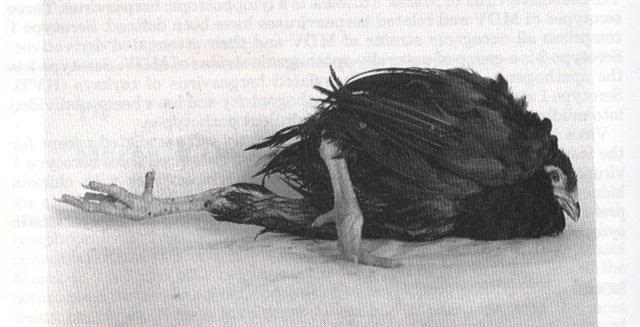
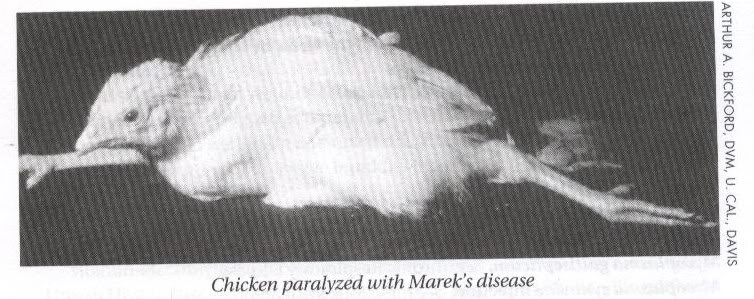
Marek's Disease has also been called MD, neuritis, neurolymphomatosis, range paralysis (eye form: gray eye, iritis, ocular lymphomatosis, uveitis)
System/Organ Affected - organs (liver, lungs, and others), nerves, or skin.
Incubation Period - 2 weeks
Symptoms
- in chicks over 3 weeks old (most commonly 12 to 30 weeks): growing thin while eating well (most common form), deaths starting at 8 to 10 weeks and persisting until 20-25 weeks.
- in maturing birds (6-9 months old): enlarged, reddened feather follicles or white bumps (tumors) on skin that scab over with a brown crust (skin form); stilted gait or lack of coordination, pale skin, wing or leg paralysis (involves nerve); when both legs are paralysed, one points forward and the other points back under body; sometimes rapid weight loss, gaping or gasping, transient paralysis lasting 1 to 2 days, dehydration, emaciation, coma; death due to inability to get to food and water or trampling by other chickens.

- in breeds with reddish bay eyes: cloudy grayish, dilated, irregular pupil; distorted or blinded eye
- in all ages: sudden death of apparently healthy birds
Mortality - can be nearly 100 percent; gradually increasing for up to 10 weeks, higher in pullets than in cockerels
Portmortem Findings
- in cases of sudden death, massive tumors, especially along the spinal column; otherwise, enlarged nerves with nodules (usually only on one side - compare same nerve on opposite side of body0; tumors in testes or ovary (ovary takes on a "cauliflower" appearance); solidified lungs; extremely enlarged liver, spleen, or kidneys with grayish white, soft areas; sometimes coarse, granular liver
Cause -
A number of different herpes viruses concentrated in feather follicles, shed in dander, survive for years in dust and litter.
Prevention -
Breed for resistance (some chickens carry a resistance factor); practice good sanitation; provide good ventilation; brood chicks away from adult birds until 5 months of age (by which time they develop some resistance).
Treatment -
None, cull affected birds (unless you're breeding for resistance); some tumors, particularly those of the feather follicles, clear up and the bird recovers on its own, but survivors are carriers.
Source: The Chicken Health Handbook by Gail Damerow
Info on MD from Poultry Diseases by Frank Jordan (6th ed)
Spread
By direct or indirect contact, apparently by the airborne route.
Cells from the feather follicle contaminate the environment. Shedding of infected material occurs about 2-4 weeks after infections, and can continue for the life of the bird. The virus associated with the feather debris in contaminated poultry house dust can remain infectious for many months. There is no evidence that MD is passed on through the egg.
Clinical Signs
Although clinical signs associated with MD can occur in chickens from 4 weeks of age, signs are most frequently seen between 12 and 24 weeks of age and sometimes later. The incubation period can vary from a few to many weeks. In some of the virulent pathotypes that produce severe cytolytic disease, the incubation period can be shorter. The following are some of the characteristics of the different forms of the disease.
Classical form - in this form of the disease, with mainly neural involvement, mortality rarely exceeds 10-15%, occurring over a few weeks or many months. The most common clinical sign is partial or complete paralysis of the legs and wings. The signs can vary from bird to bird depending on the involvement of the different nerves. When the nerves controlling the neck muscles are affected, signs such as bending of the head or torticollis are seen. Similarly, the involvement of the vagus nerve can result in the paralysis and dilation of the crop. Such birds may also show symptoms of gasping and respiratory distress.
Acute form - In this form of the disease, where there is usually formation of lymphomas in the visceral organs, the incidence of the disease is frequently between 10-30% and in major outbreaks can go up to 70%. Apart from generalized manifestations such as depression, weight loss, anorexia and diarrhea, the clinical signs are less marked.
Acute cytolytic disease - Severe atrophy of the lymphoid organs. Usually called 'early mortality syndrome', results in very high mortality usually between 10 and 14 days of age.
Transient paralysis - This is a rather uncommon type that occurs between 5 and 18 weeks of age. Affected birds suddenly develop varying degrees of ataxia, paresis or paralysis of the legs, wings and neck. The disease is commonly observed 8-12 days after infection, usually lasts only for about 24-48 hours and is associated with oedema of the brain. In some cases the transient paralysis can be fatal.
Some people choose to vaccinate for Marek's Disease. Here are some links to possible sources of vaccine:
http://www.intervet.com.au/species/poultry.asp
http://www.bioproperties.com.au/vaccines/index.htm
http://www.allfarm.com.au/index.php?page=details&prodid=127
and Fort Dodge Company -
1 Maitland Place Baulkham Hills 2153
phone - 1800 257 178
Here's a few links to pages with mareks informtion
http://www.thepoultrysite.com/diseaseinfo/90/mareks-disease
http://www.thepoultrysite.com/diseaseinfo/90/mareks-disease
http://fowlfacts.proboards.com/index.cgi?board=afflictiondiseaseff&action=display&thread=1183
Marek's Disease is caused by a herpes virus. It occurs mainly in chickens and is widespread amongst poultry populations throughout the world. The frustrating thing about mareks is that sometimes they appear quite well and may eat well and look fine, but they can't get up. We also often see the typical dropped wing.
Here's a couple of examples:


Marek's Disease has also been called MD, neuritis, neurolymphomatosis, range paralysis (eye form: gray eye, iritis, ocular lymphomatosis, uveitis)
System/Organ Affected - organs (liver, lungs, and others), nerves, or skin.
Incubation Period - 2 weeks
Symptoms
- in chicks over 3 weeks old (most commonly 12 to 30 weeks): growing thin while eating well (most common form), deaths starting at 8 to 10 weeks and persisting until 20-25 weeks.
- in maturing birds (6-9 months old): enlarged, reddened feather follicles or white bumps (tumors) on skin that scab over with a brown crust (skin form); stilted gait or lack of coordination, pale skin, wing or leg paralysis (involves nerve); when both legs are paralysed, one points forward and the other points back under body; sometimes rapid weight loss, gaping or gasping, transient paralysis lasting 1 to 2 days, dehydration, emaciation, coma; death due to inability to get to food and water or trampling by other chickens.

- in breeds with reddish bay eyes: cloudy grayish, dilated, irregular pupil; distorted or blinded eye
- in all ages: sudden death of apparently healthy birds
Mortality - can be nearly 100 percent; gradually increasing for up to 10 weeks, higher in pullets than in cockerels
Portmortem Findings
- in cases of sudden death, massive tumors, especially along the spinal column; otherwise, enlarged nerves with nodules (usually only on one side - compare same nerve on opposite side of body0; tumors in testes or ovary (ovary takes on a "cauliflower" appearance); solidified lungs; extremely enlarged liver, spleen, or kidneys with grayish white, soft areas; sometimes coarse, granular liver
Cause -
A number of different herpes viruses concentrated in feather follicles, shed in dander, survive for years in dust and litter.
Prevention -
Breed for resistance (some chickens carry a resistance factor); practice good sanitation; provide good ventilation; brood chicks away from adult birds until 5 months of age (by which time they develop some resistance).
Treatment -
None, cull affected birds (unless you're breeding for resistance); some tumors, particularly those of the feather follicles, clear up and the bird recovers on its own, but survivors are carriers.
Source: The Chicken Health Handbook by Gail Damerow
Info on MD from Poultry Diseases by Frank Jordan (6th ed)
Spread
By direct or indirect contact, apparently by the airborne route.
Cells from the feather follicle contaminate the environment. Shedding of infected material occurs about 2-4 weeks after infections, and can continue for the life of the bird. The virus associated with the feather debris in contaminated poultry house dust can remain infectious for many months. There is no evidence that MD is passed on through the egg.
Clinical Signs
Although clinical signs associated with MD can occur in chickens from 4 weeks of age, signs are most frequently seen between 12 and 24 weeks of age and sometimes later. The incubation period can vary from a few to many weeks. In some of the virulent pathotypes that produce severe cytolytic disease, the incubation period can be shorter. The following are some of the characteristics of the different forms of the disease.
Classical form - in this form of the disease, with mainly neural involvement, mortality rarely exceeds 10-15%, occurring over a few weeks or many months. The most common clinical sign is partial or complete paralysis of the legs and wings. The signs can vary from bird to bird depending on the involvement of the different nerves. When the nerves controlling the neck muscles are affected, signs such as bending of the head or torticollis are seen. Similarly, the involvement of the vagus nerve can result in the paralysis and dilation of the crop. Such birds may also show symptoms of gasping and respiratory distress.
Acute form - In this form of the disease, where there is usually formation of lymphomas in the visceral organs, the incidence of the disease is frequently between 10-30% and in major outbreaks can go up to 70%. Apart from generalized manifestations such as depression, weight loss, anorexia and diarrhea, the clinical signs are less marked.
Acute cytolytic disease - Severe atrophy of the lymphoid organs. Usually called 'early mortality syndrome', results in very high mortality usually between 10 and 14 days of age.
Transient paralysis - This is a rather uncommon type that occurs between 5 and 18 weeks of age. Affected birds suddenly develop varying degrees of ataxia, paresis or paralysis of the legs, wings and neck. The disease is commonly observed 8-12 days after infection, usually lasts only for about 24-48 hours and is associated with oedema of the brain. In some cases the transient paralysis can be fatal.
Some people choose to vaccinate for Marek's Disease. Here are some links to possible sources of vaccine:
http://www.intervet.com.au/species/poultry.asp
http://www.bioproperties.com.au/vaccines/index.htm
http://www.allfarm.com.au/index.php?page=details&prodid=127
and Fort Dodge Company -
1 Maitland Place Baulkham Hills 2153
phone - 1800 257 178
Here's a few links to pages with mareks informtion
http://www.thepoultrysite.com/diseaseinfo/90/mareks-disease
http://www.thepoultrysite.com/diseaseinfo/90/mareks-disease
http://fowlfacts.proboards.com/index.cgi?board=afflictiondiseaseff&action=display&thread=1183
 Re: Marek's Disease
Re: Marek's Disease
I had to put an orpington down about 18 months ago. She had lymphomas in the skin around the feather follicles. She had also lost weight. This is what I first spotted:
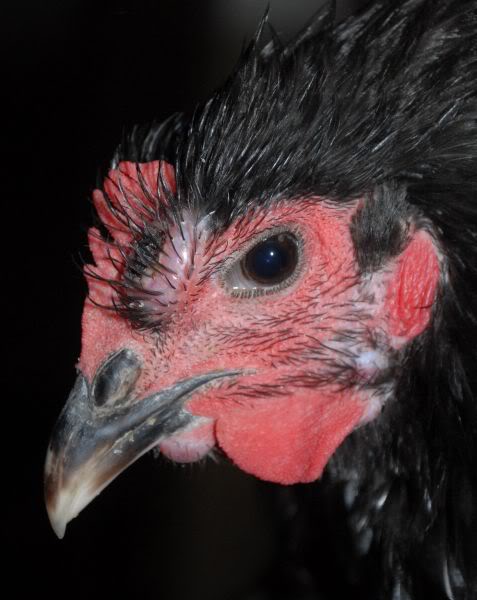
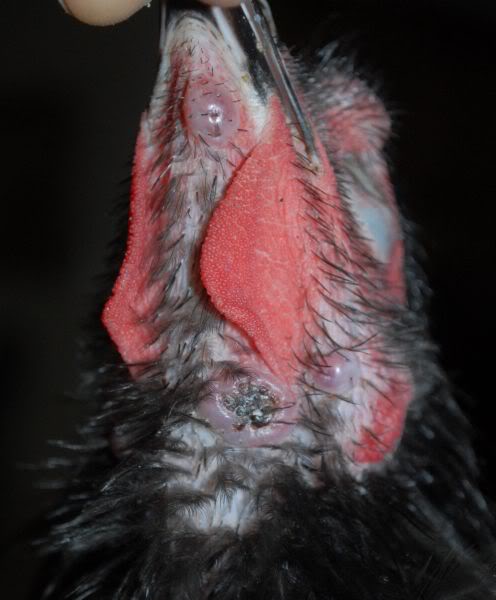
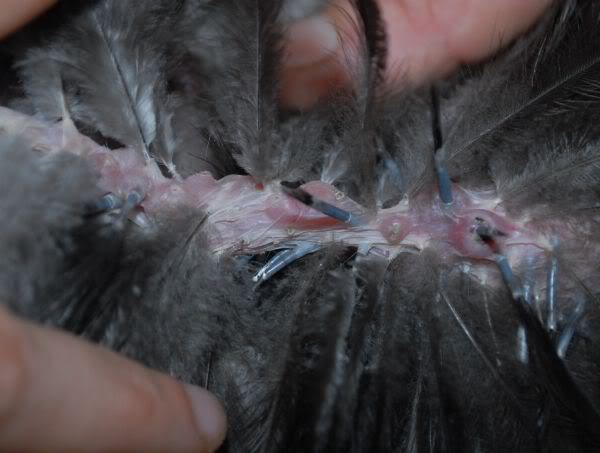
Sadly, I realised what it was straight away and she was off to the chopping block. There was nothing I could do for her. As it isn't that common in this form I plucked some feathers so I could get shots to show the lymphonas all over her body.
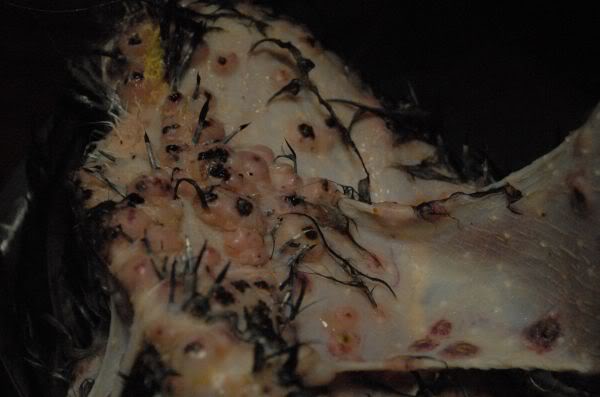

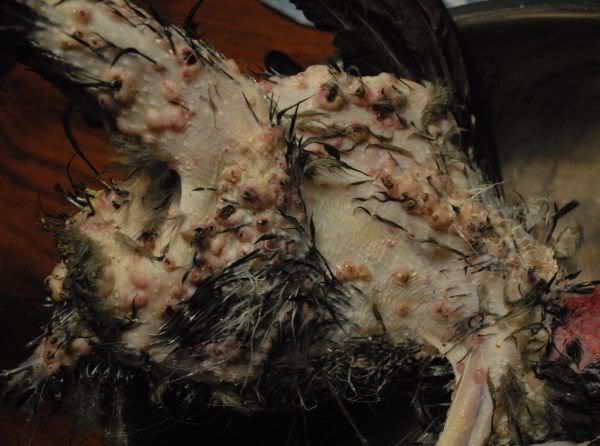
I'm pretty sure that if we'd opened her up we would have seen tumours everywhere.
We got this line of birds from a well known breeder who vaccinates all bird for mareks. This was the next generation. They have little resistance.



Sadly, I realised what it was straight away and she was off to the chopping block. There was nothing I could do for her. As it isn't that common in this form I plucked some feathers so I could get shots to show the lymphonas all over her body.



I'm pretty sure that if we'd opened her up we would have seen tumours everywhere.
We got this line of birds from a well known breeder who vaccinates all bird for mareks. This was the next generation. They have little resistance.
 Re: Marek's Disease
Re: Marek's Disease
Although fairly rare, grey eye is a condition that can arise when Marek's Disease produces tumourish growth in the iris of the eye. This is a 1 year old wyandotte cockeral. His eye looked very different to the hens. At this point he seemed to be in good health. He ate, moved and behaved normally. The pupil gradually got smaller and smaller.
Here is the normal hen's eye.
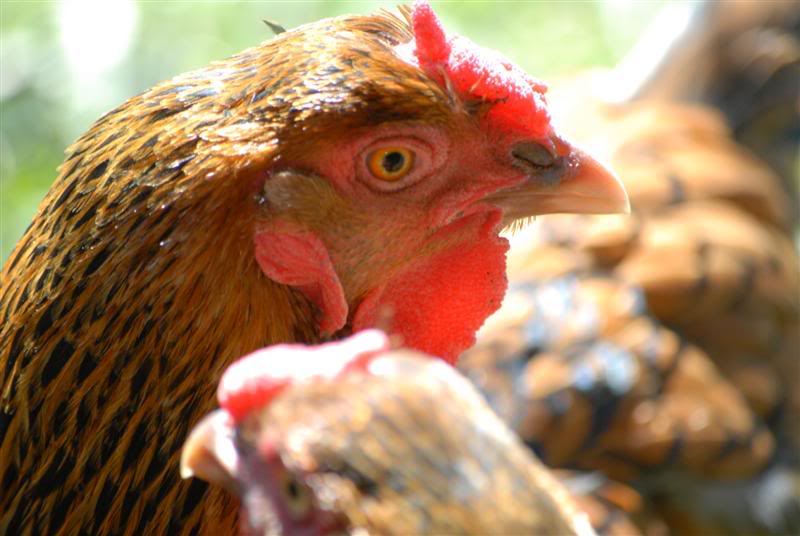
This is the cockerals slightly bigger and darker eye:
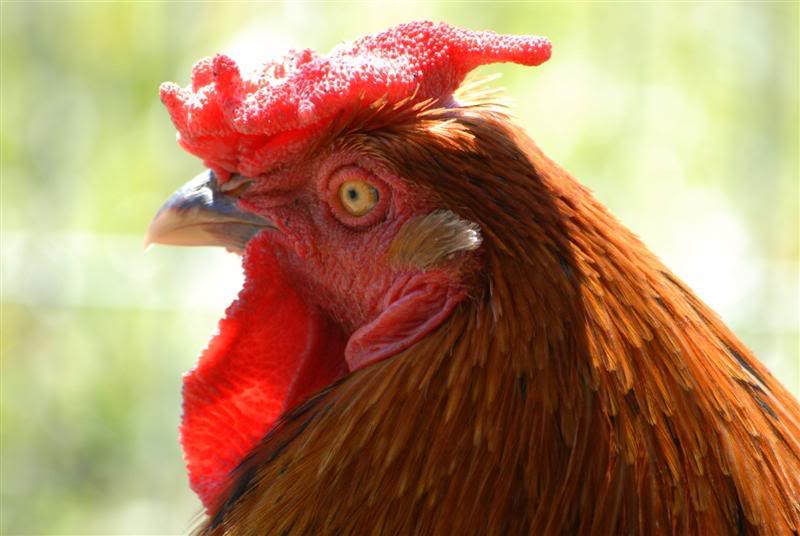
Now here's the most grey one:
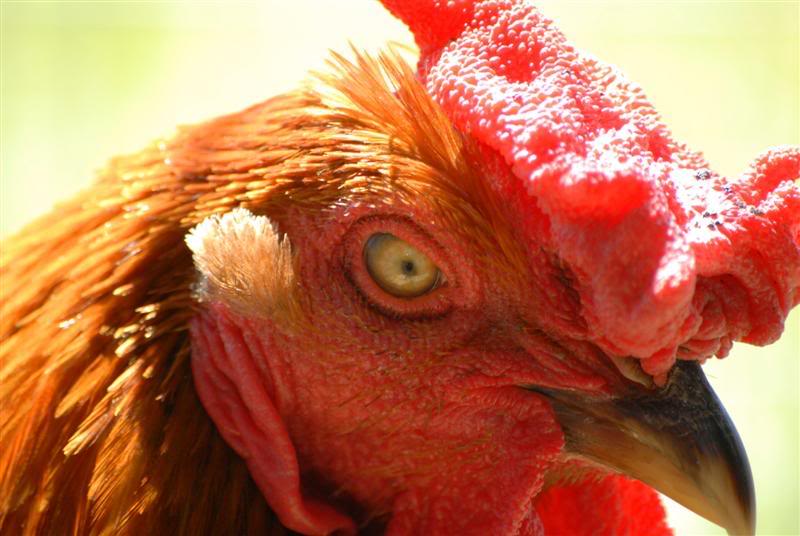
And a close up:
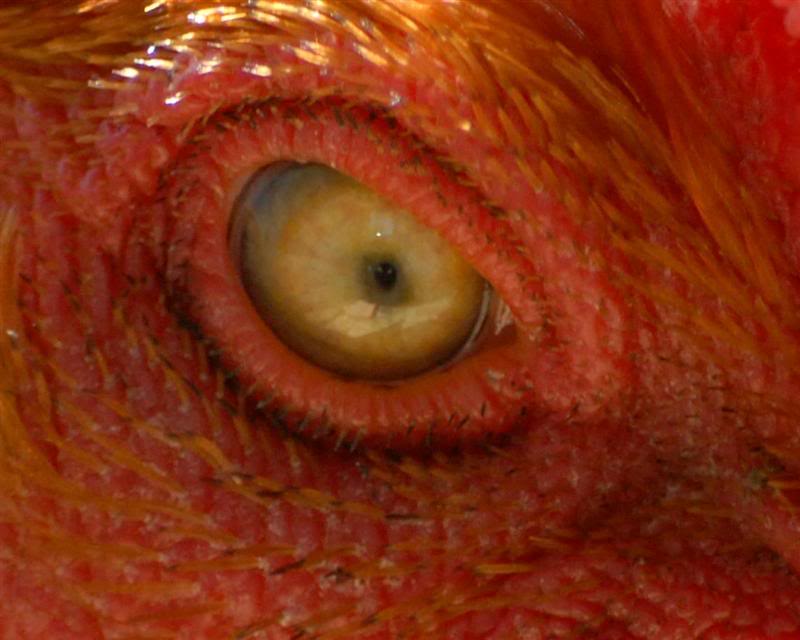
This eye was clearly not normal and the bird developed the more typical Marek's Disease symptoms about three months after this photo was taken.
Here is the normal hen's eye.

This is the cockerals slightly bigger and darker eye:

Now here's the most grey one:

And a close up:

This eye was clearly not normal and the bird developed the more typical Marek's Disease symptoms about three months after this photo was taken.
Page 1 of 1
Permissions in this forum:
You cannot reply to topics in this forum|
|
|

